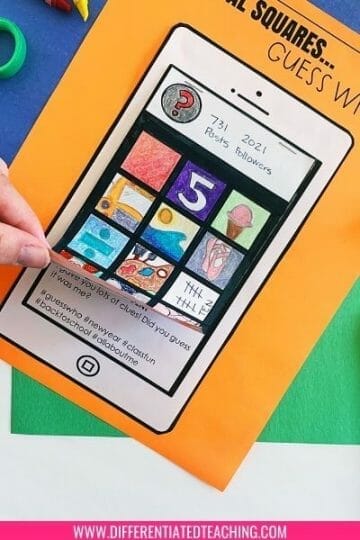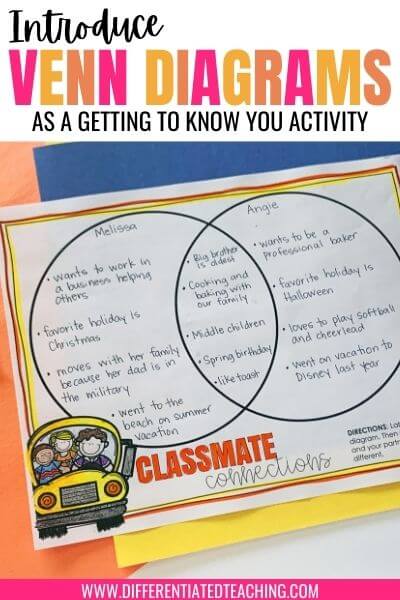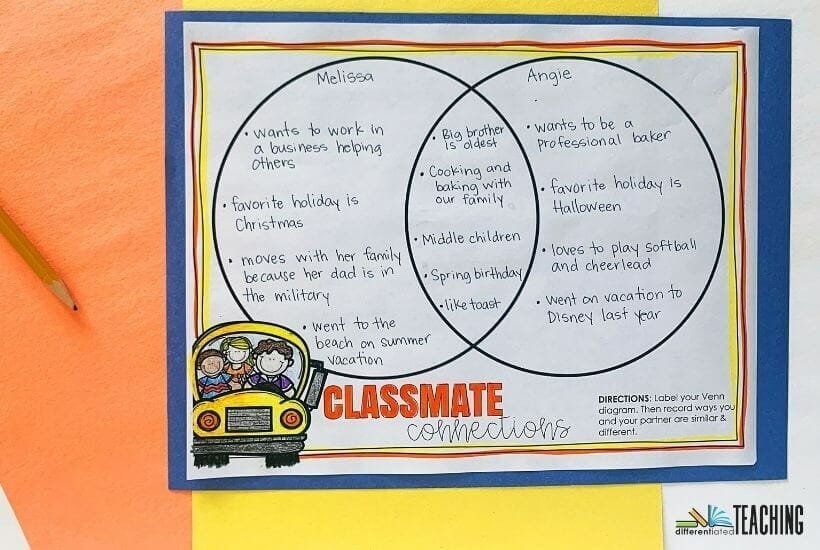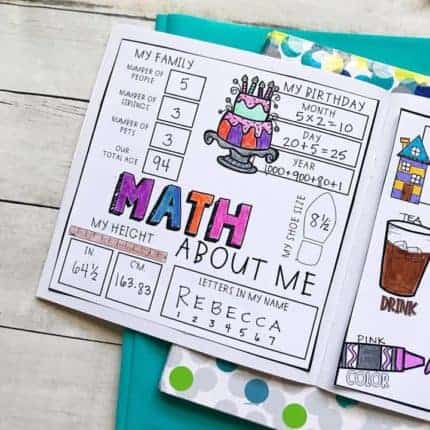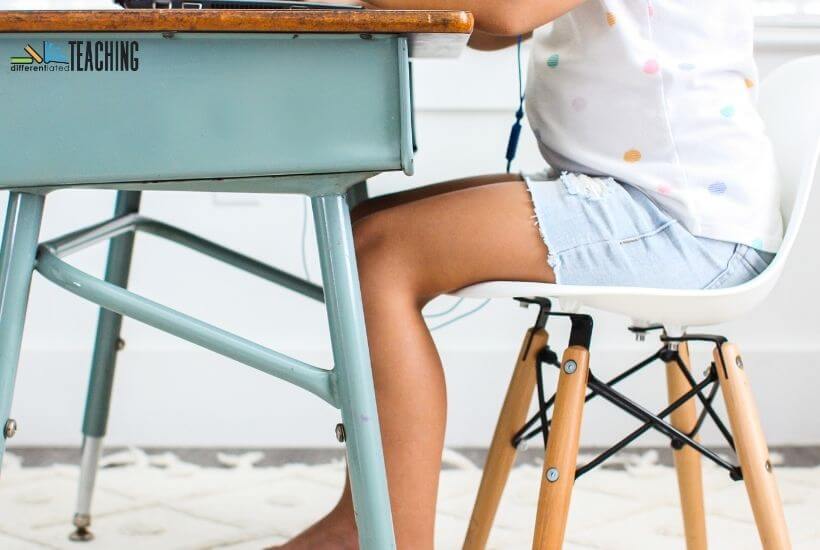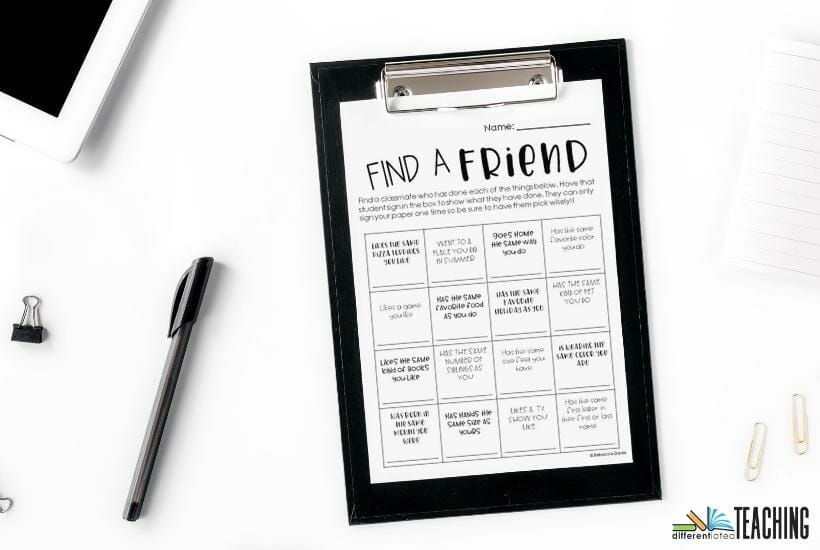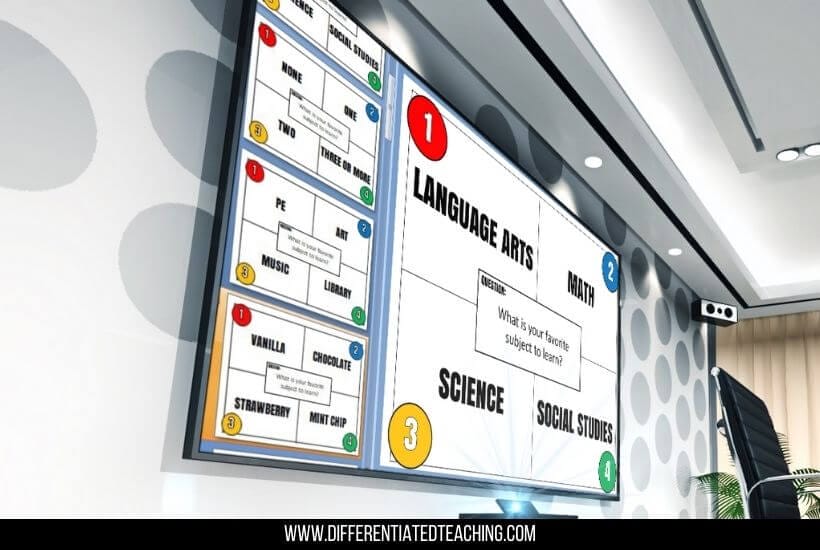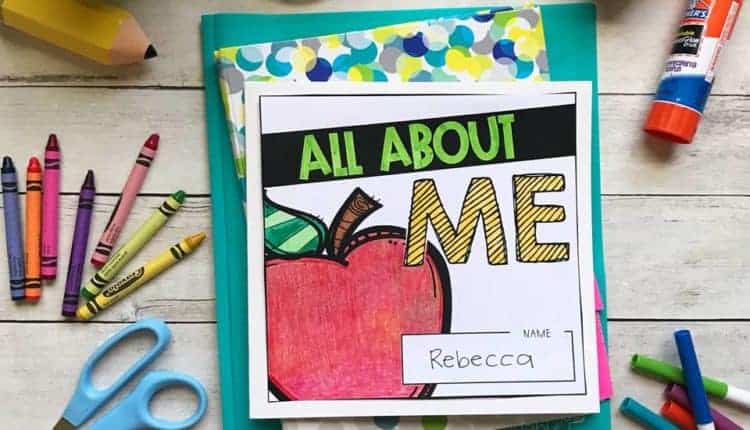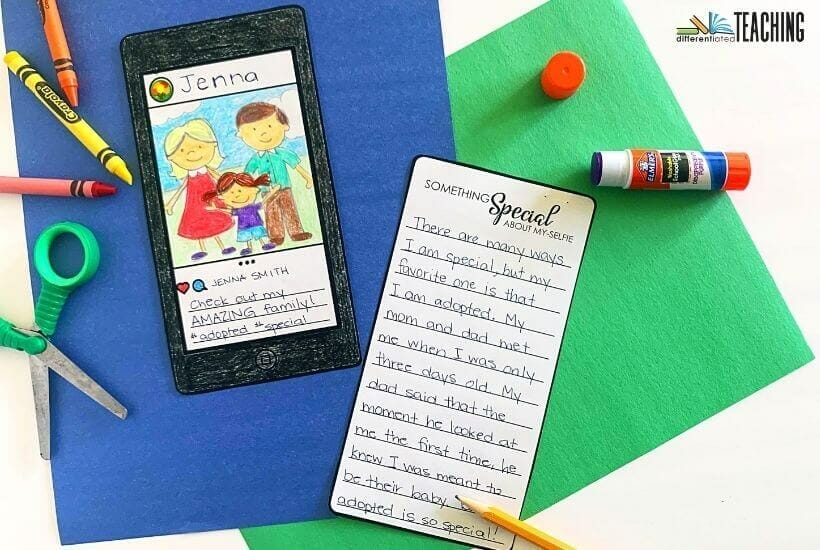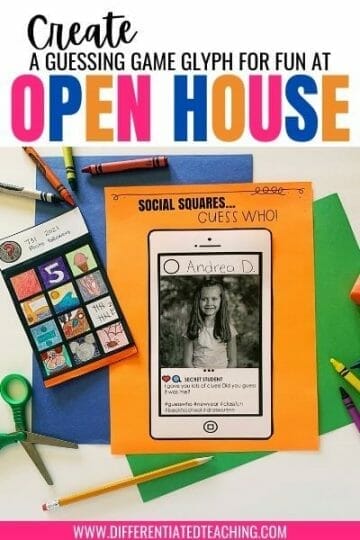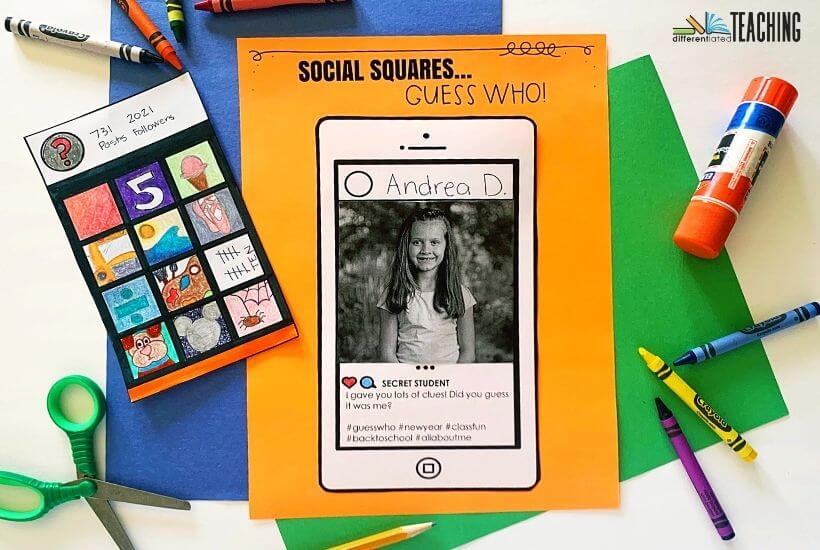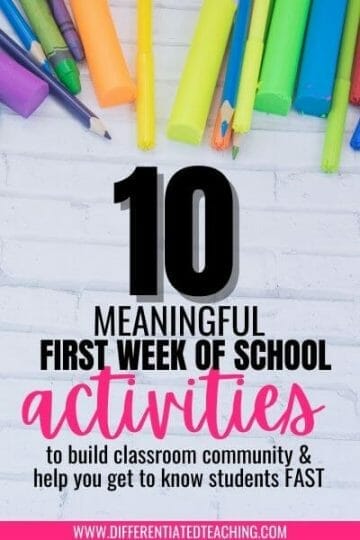10 First Week of School Activities & Lesson Ideas to Build Community
As teachers, we are always looking for new ways to engage students and build classroom community during the first week of school. There is often a lot of anxiety for both the teacher and the student as they get reacquainted after the summer break. You want your new students to feel right at home. You want them to feel connected to the class, to each other, and to you.
While the first week tends to be filled with enthusiasm, it’s important students get to know their new classmates, but you don’t want to overwhelm them with too much at once! The first days of a new school year can be overwhelming enough for shy or introverted students without adding stress.
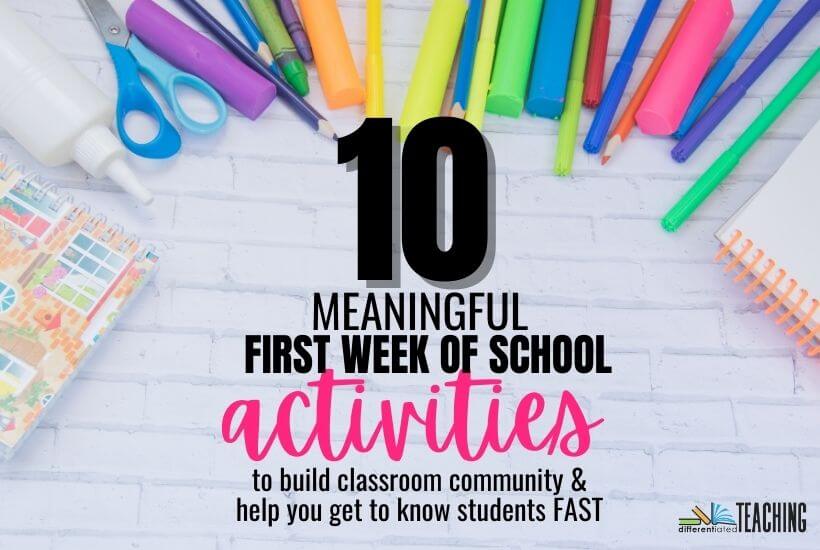
If you’re looking for fun activities for starting the year off on the right foot, you’ll love these ideas for engaging students and building classroom community with all about me activities during the first week of school.
This post contains affiliate links. While purchasing from these links does not cost you anything additional, it does mean I earn a small commission.
What is the purpose of doing All About Me Activities during the first week of school?
First week activities, such as All About Me, can seem like a time-filler during the first weeks of school when working with older students. However, they have an important role even in upper-level classrooms. First, they help students get to know one another during the first weeks of school.
In addition, All About Me activities are critical for allowing you to interact with students and learn more about their interests, strengths, and goals. This will help you give each student personalized attention and help you know all the basics you need to know about learners by the end of week 1.
Third, All About Me activities provide an opportunity for students to practice self-reflection and communication skills and can build classroom community among students who sit next to one another.
All About Me activities can also help students learn about others who are different from themselves. This can lead to more inclusive classrooms and stronger connections for all students. Lastly, they also help students practice being comfortable talking to their classmates in new ways and can be used as an ice breaker during the first weeks of school.
Great Read-Aloud Ideas to Introduce Your First Week of School Activities
One great way to introduce these community-building activities is with a high-quality read-aloud. If you typically avoid using picture books with older students, I challenge you to try it. You might be surprised to discover just how engaged they are as you read, and you might just find a new favorite book!

Here are some of my favorite back-to-school picture books to read aloud during the first days of school.
- Most Marshmallows by Rowboat Watkins
- The Day You Begin by Jacqueline Woodson
- Extra Yarn by Mac Barnett
- Mary Wears What She Wants by Keith Negley
- Remarkably You by Pat Zietlow Miller
- All the Ways to Be Smart by Davina Bell
If you’re looking for more great options, I’ve shared a whole list in this post: 26 Great Back-to-School Books to Build Community.
10 Great First Week of School Activities to Build Classroom Community
As you start to write those first-week lesson plans, you might be struggling to figure out what activities you want to incorporate into your plans. It can be hard to come up with something that students haven’t already done year after year, especially as they begin to reach upper elementary.
If you’re looking for new All About Me activities for the first week of school, try these ideas. They each have a unique focus to help students build classroom community and engage with their teachers and classmates.
1. Use Venn Diagrams to find similarities and differences with a classmate.
It’s never too early to introduce your students to graphic organizers, and the Venn diagram is one that you’ll use again and again. So this year, introduce your students to a Venn diagram for All About Me activities.
Begin by reviewing the purpose of the Venn diagram – to compare and contrast two things. Then pair up students with their classmates and have them work to brainstorm ways they are similar and different from one another.
These make a great display on a back-to-school bulletin board, and it’s one of those practice activities that also help introduce several important academic vocabulary terms that students will need to understand. In addition, this offers a hook that you can refer to throughout the year when you work with Venn diagrams.
2. Get poetic with your writing activities on the first week of school.
I love using poetry as a way to help students share about themselves and their experiences. Poetry can be an excellent vehicle for self-reflection since it asks students to look inside themselves and discover something unique about their lives. Writing poetry is also a great way to build personal connections between students and their lives outside school.
Acrostic poems can be a great All About Me activity for a writing class. Students can create their own poems using the letters of their names to begin each line. If they have difficulty thinking of things to include, here are a few ideas that you can prompt them with:
- Share something unique about yourself that you haven’t shared before.
- Indicate your favorite thing to do.
- _______ is my favorite subject in school.
- I like to play with ________.
- A place I’d like to visit is ________
- My favorite food is ________.
Alternatively, you can have students create an “I Am” poem to share about themselves and their hopes for the year. These can be an excellent way for students to introduce themselves to others, and they also make an incredible display if your school has an Open House or Parent Night.
How to make it work:
There are two typical formats for this type of poetry, so you can select which one you prefer depending on what grade level you’re teaching and the needs of your learners.
- Option 1: Formulaic “I Am” poetry offers students basic sentence starters for each line of the poem. Each line should follow the pattern of “I (verb) ________.” They fill in the blanks with their answers to create the finished poem. Jen Runde from Runde’s Room shares a great example she used for her 6th graders on her blog here.
- Option 2: Free verse gives more flexibility and is great for older students or creative writing classes. In this situation, each writer can create their own idea of how each line should begin rather than a template. While the poem still follows the pattern where each line starts with “I (verb)…”, this offers more opportunities for students to express themselves as individuals.
3. Try a unique spin on a Math About Me activity during the first week of school.
Add a little arithmetic to your All About Me activities by creating Math About Me sheets. You might have already created a Math About Me sheet to introduce each student to the class, but if you haven’t, it’s a great addition to a first-week activity, and it makes a fun display. Alternatively, you can put them together to create a fun class book!
Math About Me is fun because it goes beyond the basics of listing favorite movies or book characters as you might use in another class discussion activity with elementary students. Instead, your learners get hands-on with math to describe themselves and share with their classmates.
Here’s a version I’ve used in my own classroom as an introductory math activity:
4. Have students film a commercial – Great for remote learners.
If you’ve got a tech-savvy group or you’re meeting virtually via Google Meet, it can be fun to have your students write a short commercial about what makes them a wonderful friend to have. It also provides an opportunity to introduce some basics of media literacy and the art of persuasion right from those first days.
The goal is to make a 30-second video telling about themselves and why they make a great friend. This is an excellent opportunity to introduce students to the art of storytelling, and you can use it as a light-hearted icebreaker. Plus, it can be fun to have a showing of all the commercials students made.
You never know! You might spark a new friendship!
5. Do a Find a Friend Activity to help students meet their classmates.
We’ve all done a “Find Someone Who” activity before, and there’s a good reason why!
These offer a great opportunity for students to mix and mingle while learning about their classmates. The first days of school can be a lot of sit-and-get. Listening to rules, learning procedures, and getting acclimated.
This activity is an opportunity to get up and moving!
The goal is to find a classmate who meets each of the criteria listed on the provided sheet, and you can design these to be as basic or deep as you want. For example, have students find someone who has the same favorite color, or you might see if they can find someone who speaks another language.
This can be a great activity to incorporate into your morning meetings for elementary students because it offers a chance for conversation. You can direct how deep or basic the questions are. Since these meetings are all about relationship building, students need the opportunity to talk to one another, and this type of activity is a great way to do that from the first day of school.
Take a peek at the photo above, and enter your information to get the activity I used as part of my classroom icebreakers for free.
6. Play Four Corners to get kids up and moving.
Speaking of getting kids moving, you can also try a game of Four Corners as an All About Me first day of school activity. It’s a kind of “Simon Says” game, but instead of following the directions, students have to move to the spot that best describes their answer. So, for example, students may go to different parts of the room depending on their favorite subject or how many siblings they have.
The game will require students to get up and move around and it might help them to put aside their fears and just go for it! This is also a great way for you to get some time to observe your students and see who would be a good match for your small groups.
By observing where students are, you can get a sense of their interests and strengths. For example, you might find one or two students who always go to the same spot every time. If so, they might be a great fit for a small group activity focused on that subject area. This can help you make some quick determinations about how you’ll organize your small groups and work with your kids throughout the year.
A handy hint is to pre-label your corners with colors or letters to make the game run smoothly. Then you can put the answer choices on your projector (like above) and have students move to the right corner without much hassle.
7. Complete an All About Me Book as a part of your first week of school activities.
Having students create an All About Me Book can be a fun way to get to know your learners while making a purposeful end product.
You can use the 8×8 booklets from the Target Dollar Spot with blank pages and let students write about anything they want. Alternatively, you can provide a more structured framework using a book template that has students complete pre-made pages and templates to share information about themselves.
Here’s a fun example I’ve used with my learners in the past:
Read more about this resource here: All About Me Books: A Back-to-School Activity.
8. Have students write a letter to their future selves.
This can be a really meaningful one, especially if you’re teaching a grade level that is the start or end of a big transition year. For example, the fifth-grade teachers at one school I worked at did this with their students. Then, when the students went to middle school the following year, they would mail the letters to them at the end of the school year.
One of the great things about having students write a letter to their future selves is that it gives them the chance to think about their lives differently and be more intentional about their education. It can also be a great way to make predictions about how they will get along in middle school.
9. Make Getting to Know You Fortune Tellers
At some point, most students get into making fortune tellers, so why not use it to your advantage and make it into a fun getting to know you activity. Have students create their own fortune teller using a pattern or template in the classroom. You might even consider using some of the prompts I’ve shared in my post 20 Questions to Get Kids Talking.
You can pre-write some questions onto the template before copying it, or you can allow students to add their own questions. If you have students add their own questions to the template, be sure to remind them not to write anything too personal. Fortune tellers are fun, but you’ll need to monitor students to ensure the questions being asked are school-appropriate.
When they use their fortune teller with a peer, the classmate must answer the question under the flap they selected. Then they can mingle again and repeat the process.
Add a little music, like Musical Chairs, to make it extra fun. Of course, whoever they are standing near when the music stops is their partner that round.
Covid hint for First Week of School Activities– This is also an awesome idea for reducing germs that often spread during some team-building activity ideas commonly used at the beginning of the year – like the questions on a beach ball activity.
10. Create All About My-Selfies!
The 10th activity I want to share is one that upper elementary students and middle school students love! If you’re working with a grade level interested in social media, this can be a fun way to tap into this. You can grab this project here.
I’ve done this activity in two ways in the past.
Option 1: Have students identify what makes them unique.
First, I’ve had students draw a selfie showing something about them that makes them unique. Then they write a caption and hashtags to match. We did these on phone templates and used them to make a cute display. However, they were also a great talking point between students.
Option 2: Play Secret Selfie
The other option is a guessing game, which can be fun if students have been together for several years and think they already know one another pretty well. In this case, prompt students to draw a picture that matches various likes and dislikes into each square. For example, you might say, “Draw something that represents your favorite color in the first frame.” Continue this until you’ve done the entire 9 or 12-square.
Once all the boxes are complete, students draw a secret selfie (or take a picture of each student) to place underneath and attach their clues over the top, like in the image below. Then display them with numbers attached and have students try to guess who is who!
This is also a great one for displaying during Open House! It is entertaining to watch parents try to guess which one their child made!
The benefits of taking time for All About Me activities during the First Week of School
Classroom community matters. Students who feel connected to their teacher and classmates are more likely to do well and less likely to drop out.
In addition, all About Me activities create a safe environment for students to share personal information and build relationships. It is surprising how much safer it is to share personal opinions when your class feels safe and comfortable with one another.
By including all about me ideas as part of your first week of school activities, the classroom transforms into a community, and your elementary students become less nervous when it’s time for them to share their ideas and opinions.
How do you foster classroom community from the very first day?


